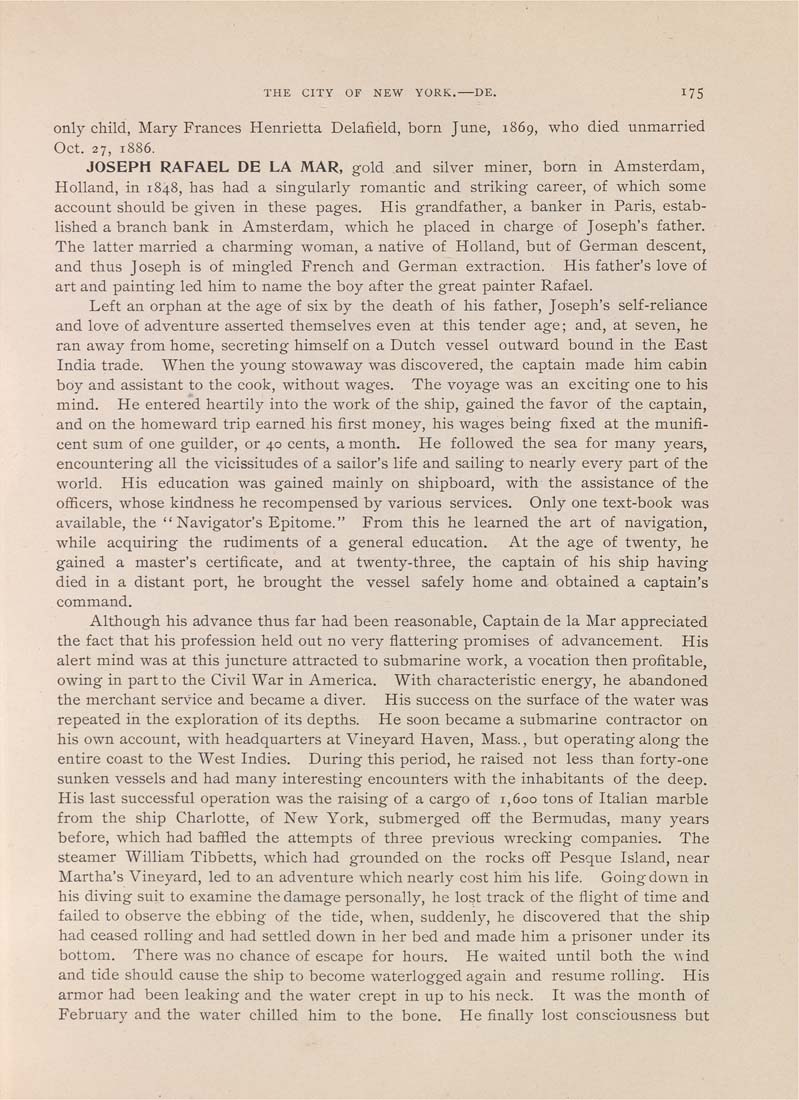THE CITY OF NEW YORK.----DE. 175
only child, Mary Frances Henrietta Delafield, born June, 1869, who died unmarried
Oct. 27, 1886.
JOSEPH RAFAEL DE LA MAR, gold and silver miner, born in Amsterdam,
Holland, in 1848, has had a singularly romantic and striking career, of which some
account should be given in these pages. His grandfather, a banker in Paris, estab¬
lished a branch bank in Amsterdam, which he placed in charge of Joseph's father.
The latter married a charming woman, a native of Holland, but of German descent,
and thus Joseph is of mingled French and German extraction. His father's love of
art and painting led him to name the boy after the great painter Rafael.
Left an orphan at the age of six by the death of his father, Joseph's self-reliance
and love of adventure asserted themselves even at this tender age; and, at seven, he
ran away from home, secreting himself on a Dutch vessel outward bound in the East
India trade. When the young stowaway was discovered, the captain made him cabin
boy and assistant to the cook, without wages. The voyage was an exciting one to his
mind. He entered heartily into the work of the ship, gained the favor of the captain,
and on the homeward trip earned his first money, his wages being fixed at the munifi¬
cent sum of one guilder, or 40 cents, a month. He followed the sea for many years,
encountering all the vicissitudes of a sailor's life and sailing to nearly every part of the
world. His education was gained mainly on shipboard, with the assistance of the
officers, whose kindness he recompensed by various services. Only one text-book was
available, the "Navigator's Epitome." From this he learned the art of navigation,
while acquiring the rudiments of a general education. At the age of twenty, he
gained a master's certificate, and at twenty-three, the captain of his ship having
died in a distant port, he brought the vessel safely home and obtained a captain's
command.
Although his advance thus far had been reasonable. Captain de la Mar appreciated
the fact that his profession held out no very flattering promises of advancement. His
alert mind was at this juncture attracted to submarine work, a vocation then profitable,
owing in part to the Civil War in America. With characteristic energy, he abandoned
the merchant service and became a diver. His success on the surface of the water was
repeated in the exploration of its depths. He soon became a submarine contractor on
his own account, with headquarters at Vineyard Haven, Mass., but operating along the
entire coast to the West Indies. During this period, he raised not less than forty-one
sunken vessels and had many interesting encounters with the inhabitants of the deep.
His last successful operation was the raising of a cargo of 1,600 tons of Italian marble
from the ship Charlotte, of New York, submerged off the Bermudas, many years
before, which had baffled the attempts of three previous wrecking companies. The
steamer William Tibbetts, which had grounded on the rocks off Pesque Island, near
Martha's Vineyard, led to an adventure which nearly cost him his life. Going down in
his diving suit to examine the damage personally, he lost track of the flight of time and
failed to observe the ebbing of the tide, when, suddenly, he discovered that the ship
had ceased rolling and had settled down in her bed and made him a prisoner under its
bottom. There was no chance of escape for hours. He waited until both the -wind
and tide should cause the ship to become waterlogged again and resume rolling. His
armor had been leaking and the water crept in up to his neck. It was the month of
February and the water chilled him to the bone. He flnally lost consciousness but
^
1
|








